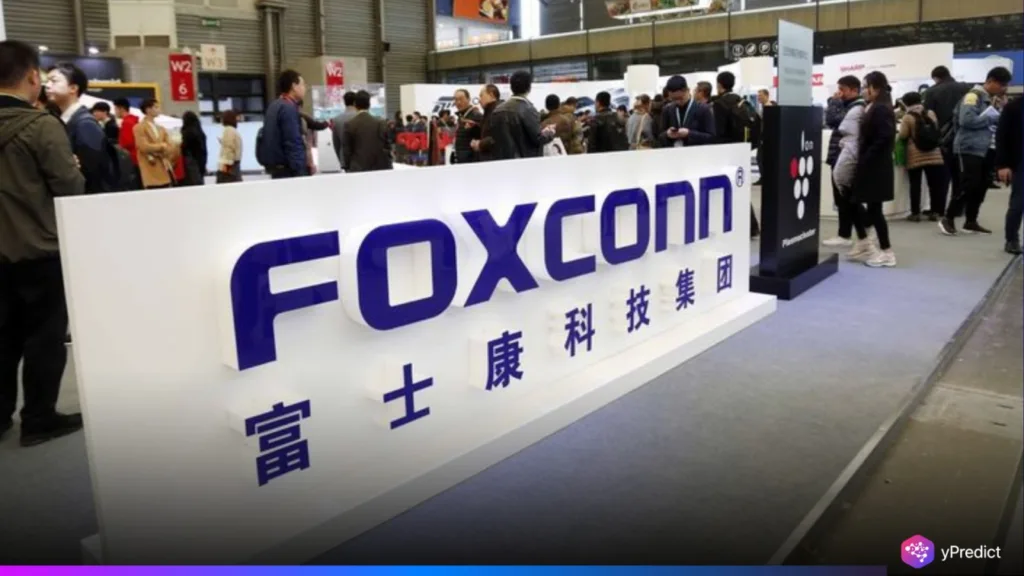
Foxconn, formally known as Hon Hai Precision Industry Co., recorded a sharp decline in sales growth this July, dipping to 7.25% year-on-year. The drop, which translates to NT$613.8 billion in revenue, comes as a stark contrast to the company’s earlier double-digit gains. Market observers had estimated a 12.2% growth rate and projected that it would miss that level of growth. The slowdown in growth is generally attributable to tariff uncertainty, which is still a drag on demand for global electronics and AI infrastructure spending. With Foxconn operating in this environment of uncertainty, the strategic shift toward Nvidia servers and AI manufacturing in the U.S. reflects a clear pivot in response to rapid economic uncertainty.
Tariff Uncertainty Pressures Core Electronics Demand
Foxconn’s core business, including iPhone assembly and electronics manufacturing, is under pressure due to rising tariff uncertainty. The ongoing trade debate in the United States has fueled widespread investor concern. A Deloitte report from April 2025 revealed that the S&P 500 dropped 17.4% since February, largely driven by nervousness surrounding evolving trade policies. That drop corresponds to the rising anxiety across the tech manufacturing landscape.
Foxconn’s customers – including some of the biggest players on the globe, such as Apple and Nvidia, still face geopolitical risk. Demand visibility is becoming increasingly murky as tariffs threaten key components and routes of shipping. This unpredictability directly impacted Foxconn’s sales last month. Global firms are now looking beyond traditional production hubs, and Foxconn’s management is already reacting to this shift.
AI Strategy Gains Momentum with U.S. Expansion
Amid the slowdown, Foxconn has ramped up its AI ambitions. Its pivot to Nvidia servers—critical to next-generation AI data centers—shows how the company is repositioning itself. A major development came with the $375 million sale of its Ohio plant, reported by Bloomberg on August 4, 2025. This transaction marks a significant milestone in Foxconn’s reconfiguration of its U.S. operations.
Instead of reducing its U.S. footprint, Foxconn is repurposing many of its assets to focus on AI server assembly. Nvidia servers are high-value products with a strong growth rate, particularly as enterprises and governments ramp up investment in AI capabilities. The company is betting on artificial intelligence as a hedge against electronics volatility and tariff-linked setbacks.
India’s Electronics Push Offers a Secondary Growth Path
In parallel, Foxconn is aligning with India’s long-term goal of building a $500 billion electronics industry by 2030–31. The Indian Cellular and Electronics Association (ICEA) has backed this vision, which includes greater AI infrastructure development. Partnerships and possible shifts in manufacturing to India are added to Foxconn’s strategy for diversification, to hedge against both U.S.-China trade friction and overexposure in a single market.
The spatial distancing is indicative of Foxconn’s future paradigm, AI-first, portfolio balanced on a global scale, and insulated from any tariff shocks. As the company integrates Nvidia servers into its next phase of development, both the U.S. and India will likely play vital roles in its future revenue streams.
Foxconn Sales Signal Need for AI-Centric Realignment
The decline in Foxconn sales in July 2025 isn’t just a revenue dip—it’s a warning sign for legacy electronics manufacturers clinging to older business models. AI is no longer a tech side story; it’s becoming the main plot. Nvidia servers, in particular, are at the heart of this transformation, and Foxconn seems to recognize this reality.
As global demand patterns shift and trade policies remain volatile, Foxconn is forced to adapt. It’s an AI-centered move into server assembly, and a diversified geographic playbook underlines a larger trend across the tech sector: survival now depends on how fast firms can pivot to AI.





